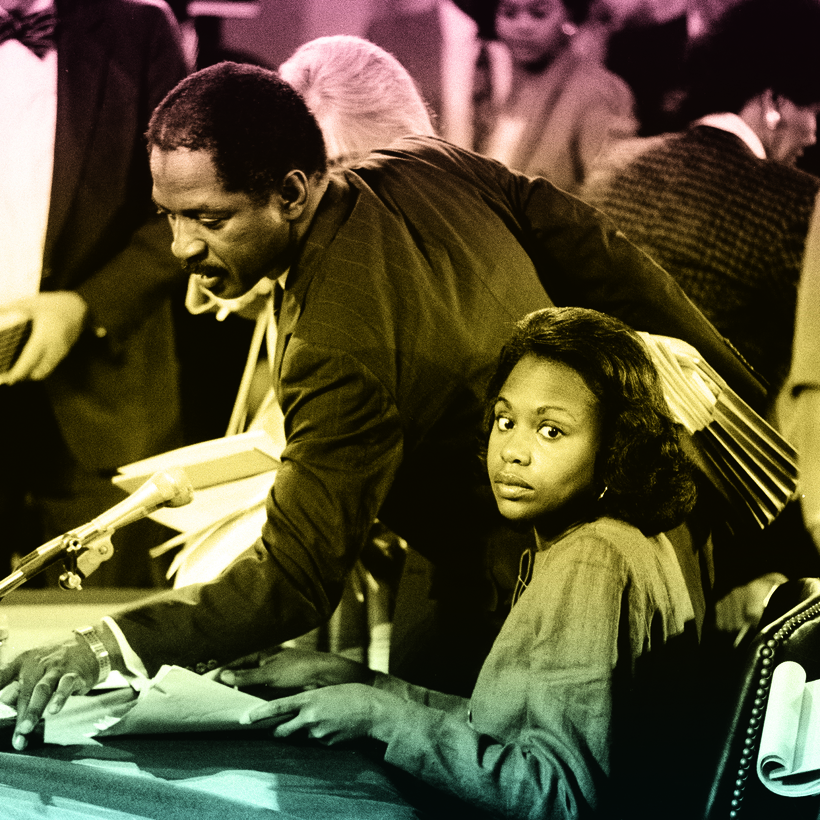Anita Hill has earned the right to say anything she wants—and to be as enraged as any one of us—yet her public career has been marked by restraint, measured speech, and sober writing.
Her third book, Believing, doesn’t deviate from that standard as it coolly reminds us how far we have not come in the three decades since Joe Biden presided over Supreme Court justice Clarence Thomas’s Senate confirmation hearing.
Then, much like the Republicans leading Brett Kavanaugh’s confirmation hearing, in 2018, Biden failed utterly to lead his fellow senators—Neanderthal, cadaverous men incredibly still in power all these years later—to respect and do right by a young Black woman courageously telling her story of Thomas’s habit of sexual harassment.
Hill starts her book off with a 1976 Redbook-magazine poll on working women and sexual harassment in the workplace (the first ever). In the accompanying article, titled “What Men Do to Women on the Job,” the problem was described as “pandemic.”
Five years later, in another Redbook poll, businessmen tended to see in workplace sexual harassment “minor special interest groups’ ability to blow up any issue” and that the issue was “somewhat overdrawn.”
On the Job
Hill relates the history of sexual-harassment law, beginning with then Yale law student Catharine MacKinnon’s theory, eventually accepted by the Supreme Court, that sexual harassment violates the Civil Rights Act. The long road to rendering that theory into applicable law included federal judges’ repeatedly ruling that far from violating civil rights, sexual harassment was simply the natural order of business between men and women. “The only sure way an employer could avoid such charges would be to have employees who were asexual,” wrote one judge.
On one of the few real advances in sexual-harassment law reported in the book, Hill writes that it took the Black Washington, D.C., appeals-court judge Spottswood Robinson III, nominated by L.B.J., to finally link sexual harassment to racial discrimination, also long treated as “not so bad” or “natural.”

There is a semblance of progress charted here. Hill reminds us, for example, that in 1991, before the televised Clarence Thomas hearing, watched by 9 in 10 Americans, at which she faced an all-male, all-white Senate panel, “sharing experiences of gender-based violence was taboo.” But even after the #MeToo movement, millions of shared experiences didn’t stop a white version of Thomas from getting his own lifetime job.
Taken as a whole, the statistics and developments Hill cites draw a rather bleak picture of women’s status in the world and specifically in the workplace—from government and law’s apparent inability to stem domestic violence and campus rape to the protective crouch most employers still retreat into when women report sexual harassment on the job.
A 1976 Redbook-magazine article on working women and sexual harassment in the workplace described the problem as “pandemic.”
Hill is in her late 60s now, and this book leads us to ask how she will be remembered. How will history frame her courage and ultimate defeat? Is she the spirit haunting the graveyard of second-wave feminism? Intersectional feminism’s first great avatar, complicated by accusing a Black man—an act that won her, Hill writes, additional hate from many in the Black community?
Hill, like the rest of us, has also had to grapple with the fact that a Black president so inflamed America’s white-racist amygdala that more than 70 million still went all in for a deranged demagogue and pussy grabber, demonstrating a shockingly broad acceptance of misogyny, along with racism.
That fact taught Democrats—women’s only hope in the current American political system—that their safest bet for the foreseeable future was to run a white grandpa for president. It is unlikely, in my view, that a woman—certainly not a woman from left of center—can be elected president in Hill’s lifetime.
“We’re left to wonder if recognition of women’s value must come before we can secure full political participation,” Hill writes.
One hopes that Hill is not destined to be just a footnote to the seating of a reactionary conservative, a man who in a just world she would have prevented from getting a lifetime job aimed at maintaining power against the powerless. For that is the ultimate purpose of Clarence Thomas’s being put on the Supreme Court, as it is Brett Kavanaugh’s.
The book’s subtitle, Our Thirty-Year Journey to End Gender Violence, is somewhat misleading, as the end is nowhere in sight. Hill, like all the women of her generation, has been fated to live most of her adult life in a regressive era.
As a leader, though, she carved a public albeit perilous path for a legion of #MeToo followers. Decades on, that led to a new era of awareness, at least. Individual and high-profile examples (the sacking of Matt Lauer and Bill O’Reilly, the imprisonment of Harvey Weinstein) should be as much a deterrent to the average office predator as the stocks and hangings in the public square were to medieval criminals.
Hill sees another advance, too, however slight: the scales are off all of our eyes. The provoked enemy is no longer hiding, but on the attack, from forced childbirth in Texas to fascists in Congress and a packed far-rightist high court on the cusp of turning America into Argentina or Ireland when it comes to reproductive rights.
There is no compromise possible now, only open warfare ahead. Hill quotes Susan Faludi, who chronicled the anti-feminist backlash of the 1980s, in 2020: “The gloves are off now. Which at least makes the backlash easier to see, if no less painful.”
Nina Burleigh is a journalist and author. Her most recent book, Virus: Vaccinations, the CDC, and the Hijacking of America’s Response to the Pandemic, is out now


